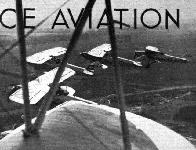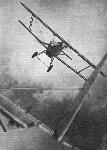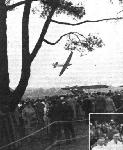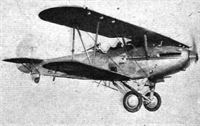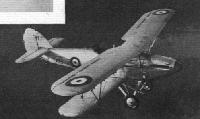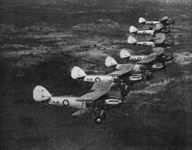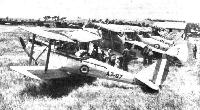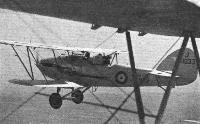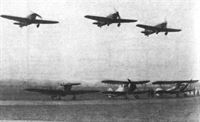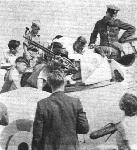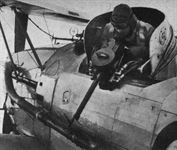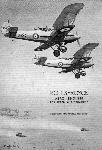
Варианты
- Hawker - Hart - 1928 - Великобритания
- Hawker - Osprey - 1930 - Великобритания
- Hawker - Audax - 1931 - Великобритания
- Hawker - Demon - 1932 - Великобритания
- Hawker - Hardy - 1934 - Великобритания
- Hawker - Hind - 1934 - Великобритания
- Hawker - PV.4 - 1934 - Великобритания
- Hawker - Hartbees - 1935 - Великобритания
- Hawker - Hector - 1936 - Великобритания
Hawker Demon и Hart Fighter
Принятие на вооружение в 1930 году самолета Hart стало качественным скачком для легкобомбардировочных сил британских ВВС и одновременно показало слабость имевшихся дневных истребителей. В ходе проведенных учений Hart оказались несколько быстрее посланных им на перехват машин. Вскоре было принято решение о разработке двухместного истребителя на базе самолета Hart. В соответствии с техническим заданием Министерства авиации 15/30, разработанным на основе результатов полученных при испытаниях варианта бомбардировщика Hart с V-образным рядным двигателем Rolls-Royce Kestrel IIS, Сидней Кэмм спроектировал новый самолет. Его вооружение состояло из двух 7,7-мм пулеметов Vickers в носовой части и одного пулемета Lewis на турели в задней кабине, имевшей вырез для увеличения зоны обстрела.
Прототип, переделанный из бомбардировщика, получил название Hart Two-Seat Fighter, вскоре сокращенное до Hart Fighter. За ним последовал второй переделанный прототип, а затем и шесть серийных самолетов, которыми с апреля 1931 года вооружили одно звено 23-й эскадрильи. Учения 1931 года показали, что Hart Fighter оказались единственными истребителями Королевских ВВС, способными перехватить бомбардировщики Hart, несмотря на довольно близкие летные характеристики. Но высокая скорость истребителя Hart осложняла работу стрелка, которому набегающий поток воздуха мешал наводить пулемет. Чтобы решить эту проблему, между кабинами установили два дефлектора, и, кроме того, кабину пилота снабдили рудиментарным фонарем, создававшим зону спокойного воздуха над стрелком. Решение оказалось удачным, и стрелку больше не приходилось прилагать чрезмерно большие усилия, чтобы обращаться с пулеметом.
В начале 1932 года было выпущено техническое задание 9/32 на улучшенный вариант Hart Fighter, а затем размещен заказ на первые 17 серийных истребителей, в июле 1932 года получивших название Demon. Первый из этих самолетов Demon Mk I взлетел в феврале 1933, а к апрелю того же года была готова вся партия, что позволило полностью укомплектовать новыми истребителями 23-ю эскадрилью. Эти машины были оснащены двигателем Kestrel IIS мощностью 485 л. с. (362 кВт). В общей сложности до декабря 1937 года ВВС получили 234 Demon Mk I, включая 106 самолетов, построенных компанией "Boulton Paul". Последние 49 машин постройки "Hawker" и все Demon выпуска "Boulton Paul" изготавливались по улучшенному стандарту. При тех же размерах, что и самолеты раннего выпуска, они оснащались двигателем Kestrel VDR. А с октября 1936 года все истребители производства компании "Boulton Paul" поставлялись в варианте Turret Demon Mk I, и оснащались турелью Frazer-Nash с гидравлическим приводом. Несмотря на возросшую массу и сложность конструкции, турель обеспечивала стрелку полную защиту от набегающего потока, без ограничения зоны обстрела. Позднее ею стали оснащать и ранее выпущенные машины. Последние Demon были сняты с вооружения британских ВВС в 1939 году.
В начале 1934 года Королевские ВВС Австралии (RAAF) решили заказать вариант Demon Mk I, который мог бы также использоваться в роли дневного бомбардировщика. RAAF первоначально заказали 18 самолетов Demon Mk I. Это был вариант истребителя с двигателем Kestrel VDR и вооружением из двух пулеметов Vickers Mk V в носовой части и одного подвижного пулемета Lewis в задней кабине. Их поставки начались с марта 1935 года.
Вторая партия из 36 машин, поставленных в 1936 году, имела ряд доработок, включая установку двигателя Kestrel V мощностью 600 л. с. (447 кВт), шести узлов подвески под крылом (бомбовая нагрузка до 113 кг) и организацию лежачего места для стрелка/бомбардира в нижней части фюзеляжа, где был установлен бомбардировочный прицел Mk VII. Эти самолеты отличались высокой аварийностью в основном из-за отсутствия у RAAF подходящих учебных машин. Поэтому была заказана партия из 10 Demon Mk II, снабженных сдвоенным управлением, которые также могли использоваться в качестве буксировщиков мишеней.
ТАКТИКО-ТЕХНИЧЕСКИЕ ХАРАКТЕРИСТИКИ
Hawker Demon Mk I
Тип: двухместный истребитель
Силовая установка: один V-образный рядный двигатель Rolls-Royce Kestrel VDR мощностью 584 л. с. (435 кВт)
Летные характеристики: максимальная скорость на высоте 4875 м - 293 км/ч; время набора высоты 3050 м - 7 мин 55 с; потолок 8475 м; продолжительность полета 2 ч 30 мин
Масса: пустого 1513 кг; максимальная взлетная 2117 кг
Размеры: размах крыла 11,33 м; длина 9,02 м; высота 3,17 м; площадь крыльев 32,24 м2
Вооружение: два 7,7-мм пулемета Vickers Mk III в носовой части фюзеляжа и один 7,7-мм пулемет Lewis в турели Frazer-Nash в задней кабине; до 73 кг боевой нагрузки на двух узлах подвески под крылом
- Описание
Фотографии
-
Air International 1987-01 / Model enthusiast
Регистрационный номер: K2844 A very welcome vac-form from Aeroclub Models can be completed as the Demon (K2844) of No 23(F) Sqn illustrated here. No 23(F) Sqn received this aircraft in February 1933, flying it from Biggin Hill until December 1936. Transferred to No 608 Sqn. it became an instructional airframe in October 1939.
-
Мировая Авиация 152
Регистрационный номер: K3976 [3] Demon Mk I использовался шестью эскадрильями в Британии (на рисунке самолет 29-й эскадрильи). Этими самолетами также вооружили эскадрильи на Мальте, в Адене и Египте. В конце своей карьеры Demon Mk I несли службу в пяти подразделениях вспомогательных ВВС.
-
Мировая Авиация 202
Регистрационный номер: K4500 [5] Demon. Изображен самолет в окраске 604-й эскадрильи (графство Мидлсекс) Вспомогательных ВВС, дислоцированный в Хендоне. 604-ю перевооружили на Demon в 1935 году. В 1939 году она стала эскадрильей ночных истребителей и получила Blenheim.
-
Air International 1974-03 / K.Isaacs - Australian air power
Регистрационный номер: A1-59 As WWII operations approached Australia some RAAF silver doped Hawker Demons received a ''panic” camouflage finish, and were later relegated to training units. One such aircraft was A1-59.
-
Air Pictorial 1977-05 / J.Holmes - The Hart Family (2)
Регистрационный номер: K2842 [6] The first production Demon, K2842, which flew on 10th February 1933. Cut-down rear cockpit, with canted ring to give the gunner a better field of fire, was the main feature which distinguished it from the Hart
-
Aeroplane Monthly 1991-10 / A.Lumsden - On silver wings (13)
Регистрационный номер: K2842 [6] Another photograph of K2842, the first production Hawker Demon.
-
Aeroplane Monthly 1978-08 / Personal album
Регистрационный номер: K2842 [6] An unusual photograph depicting Hawker Demon I K2842 with No 4 Flying Training School at Abu Suier, Egypt, in February 1934. Normally a two-seat fighter with a Lewis on a gun ring in the rear cockpit, this example has had that position faired over, making it a single-seater.
-
Aeroplane Monthly 1984-07 / A.Lumsden, T.Heffernan - Probe Probare (5)
Регистрационный номер: K2842 [6] The fighter variant of the Hart, re-named Demon in July 1932. From October 1936 Boulton Paul-built Demons featured a Frazer-Nash hydraulic turret.
-
Aeroplane Monthly 1991-10 / A.Lumsden - On silver wings (13)
Регистрационный номер: K2842 [6] Hawker Demon K2842 served with Nos 23, 601 and 604 Sqns after trials with the A&AEE. In April 1940 it became an instructional airframe. This first production Demon is fitted with standard tilted Scarff gun ring.
-
Flight 1936-06 / Flight
Регистрационный номер: K2842 [6] The Hawker Demon is a two-seater fighter. The Demon and Fury mount the 600 h.p. Rolls-Royce Kestrel.
-
Aeroplane Monthly 1980-11
Регистрационный номер: K2847 -
Flight 1935-06 / Flight
Регистрационный номер: K2850 [4] The "Demon" two-seater is fitted with the 525 h.p. supercharged water-cooled "Kestrel."
-
Air Pictorial 1977-05 / J.Holmes - The Hart Family (2)
Регистрационный номер: K2843 [2], K2850 [4] The Demon was introduced into R.A F. service in March 1931 when six pre-production "Hart Fighters" were delivered to No. 23 Squadron at Kenley. Shown here in No. 23's colours are four of the first true production Demons
-
Flight 1935-05 / Flight
Регистрационный номер: K2843 [2], K2850 [4] "Demon" two-seater fighters of No. 23 (F) Squadron, at Biggin Hill, in "echelon stepped up" formation.
-
Flight 1935-06 / Flight
Регистрационный номер: K2850 [4] Two-seater fighters were much used during the war and were re-introduced into the R.A.F. a few years ago. The "Demon" is the standard type, and the picture shows a flight of "Demons" of No. 23 (Fighter) Squadron, which is stationed at Biggin Hill.
-
Aeroplane Monthly 1998-10 / A.Welch - A Different World (2)
Регистрационный номер: K2853, K3784 The author regularly spotted the Biggin Hill-based Hawker Demons of 23 Squadron; she also saw them performing in the rain at the 1933 RAF Display at Hendon.
-
Aeroplane Monthly 1991-11 / O.Thetford - On silver wings (14)
Регистрационный номер: K2905, K3767 TWO-SEATER FIGHTERS: A fine close-up aerial photograph ol No. 41 (Fighter) Squadron, from Northolt. It is equipped with Hawker "Demons" and the squadron marking is a broad red band.
A formation of 41 Sqn Demons up from RAF Northolt in 1935. -
Air International 1982-05 / Fighter A to Z
Регистрационный номер: K2907 The Demon was the first two-seat fighter to be introduced by the RAF since WWI and was essentially a derivative of the Hart light bomber.
-
Aeroplane Monthly 1991-10 / Personal album. Military
Регистрационный номер: K3776 [2] A good formation photograph of Hawker Demon K3776.
-
Aeroplane Monthly 1991-10 / Personal album. Military
Регистрационный номер: K3776 [2], K3790 This formation photograph of Hawker Demons includes K3776 and K3790, both delivered to the RAF during the second half of 1934.
-
Aeroplane Monthly 1984-11 / L.Coombs - The expanding years 1936-1939 (1)
Регистрационный номер: K2854, K3793 Hawker Demons remained in RAF service well into the late Thirties.
-
Aeroplane Monthly 1991-11 / O.Thetford - On silver wings (14)
Регистрационный номер: K3974 Hawker Demon I K3974 of 29 Sqn, 15,000ft above Epping, Essex, on July 22, 1935. After passing to 41 Sqn, this Demon crashed while landing at Catterick on September 6, 1937.
-
Air Pictorial 1988-01 / J.Rawlings - No.29 Squadron - First with Tornado F.3
Регистрационный номер: K3976 [3] Hawker Demon K3976, with two red Xs. while the squadron was at Amriya. Egypt, during the Abyssinian crisis
-
Air Pictorial 1977-05 / J.Holmes - The Hart Family (2)
Регистрационный номер: K3976 [3], K3980 Demons of No. 29 Squadron, North Weald, practising for the 1935 Empire Air Day. Squadron colours consisted of red cross-hatching on fuselage sides and upper wing
-
Aeroplane Monthly 1991-11 / O.Thetford - On silver wings (14)
Регистрационный номер: K3982, K3983 Three 29 Sqn Demons. Nearest the camera is K3982, which later flew with Nos 601 and 600 Sqns before being relegated to a maintenance unit in October 1940. K2983, in the background, collided with K4538 and crashed near Dover on November 5, 1937.
-
Aeroplane Monthly 1991-11 / O.Thetford - On silver wings (14)
Регистрационный номер: K4497 [3], K4499 [3] FIENDISH ACCURACY: The Hawker Demon two-seater fighters of No. 604 (County of Middlesex) (fighter) Squadron, under the command of Sqdn. Ldr. C. P. Gabriel, rehearsing air drill for the R.A.F. Display on June 27, 1936. Any inaccuracies - which were conspicuous by their absence - would have been hidden from the permanent audience in the Hendon district by a curtain of clouds which, let us hope, will be completely rung up for the great day.
-
Aeroplane Monthly 1982-06 / J.Yoxall - County of Middlesex Demons
Регистрационный номер: K4500 [5] -
Flight 1936-07 / Flight
Регистрационный номер: K4500 [5] The Controlling Demon: Sqn. Ldr. Gabriel and his Familiar Spirit.
-
Aeroplane Monthly 1991-11 / O.Thetford - On silver wings (14)
Регистрационный номер: K4497 [3], K4499 [3], K4500 [5], K4501 [2], K4503 [2] Classic Flight photograph of 604 (County of Warwick) Sqn Demons flying from their RAF Hendon base in July 1936.
-
Flight 1936-07 / Flight
Регистрационный номер: K4497 [3], K4499 [3], K4500 [5], K4501 [2], K4503 [2] SYMMETRY in the SKY: An aerial staircase by No. 604: An excellent example of the difficult formation known as "Echelon to the Right, Stepped up."
-
Aeroplane Monthly 1991-11 / O.Thetford - On silver wings (14)
Регистрационный номер: K4510, K4511 [3], K4512 Three 208 (Army Cooperation) Sqn Demons flying over Cairo, Egypt, in December 1935. They were based at RAF Heliopolis.
-
Flight 1937-06 / Flight
Регистрационный номер: K4511 [3], K4515, K4520 [2] Dramatic "shot" of Demons of No. 64 (F.) Squadron, a tight echelon
-
Aeroplane Monthly 1988-02 / Personal album. Military
Регистрационный номер: K5683 [2], K5684 [2] Two 607 Squadron Demons up from RAF Usworth in the Thirties. K5683 was the first of a batch of 59 Demon Is delivered to the RAF between September 1936 and July 1937.
-
Air Pictorial 1977-05 / J.Holmes - The Hart Family (2)
Регистрационный номер: K5683 [2], K5684 [2], K5685, K5687 [2] Intimate close-up of Demon K5687, with K5683-5 behind, of No. 607 (County of Durham) Squadron, an Auxiliary unit based at Usworth, in the spring of 1938
-
Aeroplane Monthly 1988-02 / Personal album. Military
Регистрационный номер: K5686, K5687 [2] Two Hawker Demons of 607 Squadron (County of Durham) RAuxAF, based at RAF Usworth in the Thirties. No 607 Squadron had Usworth as its base from March 1930 until August 1939, when it moved to Abbotsinch. K5687 and K5686 became 2198M and 2030M respectively in 1940.
-
Air Enthusiast 2003-11 / A.Brew - Proud heritage
Регистрационный номер: K5904 Hawker Demons awaiting delivery outside the new factory at Pendeford.
-
Air-Britain Aeromilitaria 1986-02
Регистрационный номер: K8210 -
Flight 1934-06 / Flight
"Demon" ("Kestrel") two-seater fighters of No. 23 (Fighter) Squadron.
-
Aeroplane Monthly 1991-11 / O.Thetford - On silver wings (14)
Dramatic photograph of 64 Sqn Demons demonstrating dive bombing for Flight’s cameraman in June 1937. The squadron was then based at Martlesham Heath.
-
Aeroplane Monthly 1991-11 / O.Thetford - On silver wings (14)
THE COASTWISE PATROL: The three Auxiliary Air Force Squadrons of the London area have been enjoying a strenuous holiday at the seaside, No. 600 F.S. at Hawkinge, No. 601 at Lympne, and No. 604 at Tangmere. Here five Hawker Demons of 604 (County of Middlesex) (Fighter) Squadron are seen flying past Worthing.
Five 604 Sqn Demons off Worthing during the squadron’s summer camp in August 1936. -
Flight 1935-07 / Flight
An aerial view taken from a "Demon" of No. 23 (Fighter) Squadron in the third phase of the fly-past at Duxford. There can be seen a flight of Hawker "Demons" of No. 142 (Bomber) Squadron.
-
Flight 1935-07 / Flight
An aerial view taken from a "Demon" of No. 23 (Fighter) Squadron in the third phase of the fly-past at Duxford. There can be seen a flight of Hawker "Demons" of No. 12 (Bomber) Squadron.
-
Flight 1937-10 / Flight
CLOSE COMPANY: Hawker Demon two-seater fighters (derated Kestrel V) of No. 64 (F) Squadron caught by the Flight camera immediately after a formation take-off at Martlesham Heath.
-
Flight 1930-10 / Flight
AS THE REAR GUNNER SEES IT: The Hawker Fleet Fighter with Rolls-Royce F.MS engine photographed from a Hawker "Hart." Mr. Bulman was piloting the "Hart," and the single setter was piloted by Mr. Sayer. Note that the two machines were making a turn, simulating a flight in which the two-seater is endeavouring to prevent the single-seater from getting "on its tail."
Другие самолёты на фотографии: Fairey Fox - Великобритания - 1925Hawker Hart - Великобритания - 1928
-
Aeroplane Monthly 1991-10 / Personal album. Military
A Hawker Demon gunner’s view of another Demon, closing in fast. The Demon was armed with twin Vickers guns forward and a single Lewis gun aft. The type entered RAF service with 23 Sqn.
-
Flight 1936-07 / Flight
Squadron V: The Hawker Demons of the Squadron against a fine background of clouds.
-
Air Pictorial 1977-05 / J.Holmes - The Hart Family (2)
Smart box formation of four No. 23 Squadron Demons bearing the red and blue squares squadron insignia on their upper wings and fuselage sides
-
Aeroplane Monthly 1982-06 / J.Yoxall - County of Middlesex Demons
The Spearhead: The squadron in another of its display formations.
-
Flight 1935-05 / Flight
EMPIRE AIR DAY: A diamond formation by "Demons" of No. 23 Squadron, from Biggin Hill.
-
Air Pictorial 1977-05 / J.Holmes - The Hart Family (2)
Demons of No. 600 (City of London) Squadron, Hendon, peeling off. Note tailwheels instead of skids
-
Flight 1936-07 / Flight
For Hendon Display purposes: An unusual formation by No. 604 (County of Middlesex) (Fighter) Squadron.
-
Flight 1935-08 / Flight
No. 23 (Fighter) Squadron, which was the first unit to receive the "Demon" two-seater fighter, is here seen breaking from an echelon formation. Future "Demons" will have the 600 h.p. "Kestrel V."
-
Flight 1937-07 / Flight
"Archie" added to the fun with blank ammunition. In this picture he is seen with some Hawker Demons in the background.
-
Flight 1933-07 / Flight
DEMONS: The Secretary of State for Air inspecting No. 23 (F.) Squadron. He was accompanied by Air Marshal Sir Robert Brooke-Popham and Group Capt. H. J. Hunter.
-
Flight 1931-07 / Flight
"STRAINING AT THE LEASH": The "Bulldogs" and fighter "Harts" of No. 23 (Fighter) Squadron waiting at Kenley for orders to go up and attack raiders.
Другие самолёты на фотографии: Bristol Bulldog - Великобритания - 1927
-
Flight 1937-05 / Flight
BUSINESS BACKING: At the official opening party of the Midland Bank Flying Club. A general view of the proceedings - with one of the Club's two B.A. Swallows in the air, and, on the ground, one of the three Demons of No. 600 (F) Sqd. A.A.F. which put up a display during the afternoon.
Другие самолёты на фотографии: British Klemm L.25 Swallow - Великобритания - 1933
-
Flight 1936-05 / Flight
A camera gun on a Demon at Hendon casts its spell. Similar scenes were common at some fifty other military aerodromes.
-
Aeroplane Monthly 1979-03 / L.Curtis - Anything To Anywhere (3)
Регистрационный номер: K4411 An ATA maintenance hangar "somewhere in England" in 1942. Behind the Lockheed Hudson are a Hurricane, Demon K4411, an Oxford, Master W8905, an Argus, a Tutor, a Havard and the tail of an Anson. All were used either for the training or movement of ATA pilots.
Другие самолёты на фотографии: Airspeed Oxford / AS.10 - Великобритания - 1937Avro Anson / Type 652 - Великобритания - 1935Avro Tutor/Sea Tutor/Prefect / Type 621/646/626 - Великобритания - 1929Fairchild C-61 Forwarder / Model 24 / Argus - США - 1932Hawker Hurricane - Великобритания - 1935Lockheed Hudson A-28 / A-29 - США - 1938Miles Kestrel M.9 / Master I M.9A - Великобритания - 1937North American T-6 Texan / AT-6 Harvard - США - 1935
-
Jane's All the World Aircraft 1938 / 03 - All the world's aeroplanes
Регистрационный номер: A1-1 [4] The Hawker "Demon" Two-seat Fighter Biplane (Rolls-Royce "Kestrel" engine) as supplied to the Australian Government.
-
Aeroplane Monthly 1988-01 / D.Middleton - Sammy Wroath /Test Pilot Profile/ (15)
Регистрационный номер: A1-1 [4] One of the machines flown by Wroath at Martlesham: Australian Demon A1-1.
-
Flight 1938-09 / Flight
Регистрационный номер: A1-49 An Australian Demon general-purpose machine with Rolls-Royce Kestrel V engine.
-
Flight 1939-02 / Flight
An Australian Hawker Demon (Rolls-Royce Kestrel V) as used by the R.A.A.F. for general-purpose duties.
-
Flight 1935-03 / Flight
DEMONIACAL VERSATILITY. The first of the eighteen Hawker "Demon" two-seaters ordered by the Royal Australian Air Force is here seen being tested by Mr. M. Summers. These machines, which can be equipped for fighting, bombing, or for army co-operation work, are powered with the Rolls-Royce "Kestrel V" engine, supercharged to give a maximum of 640 h.p. at 14,000 ft. The top speed is in the neighbourhood of 190 m.p.h.
-
Flight 1935-12 / Flight
Регистрационный номер: A1-1 [4] A number of specially equipped Demons (Kestrel V) have been supplied to Australia.
-
Flight 1937-11 / Flight
Регистрационный номер: A1-3 [2] A flight of Australian Demons, incidentally, is seen making a diving attack.
-
Flight 1938-02 / Flight
A flight of R.A.A.F. Hawker Demons (R.R. Kestrel II) over Australia’s new “streamlined” train.
-
Flight 1939-11 / Flight
Регистрационный номер: A1-34, A1-35, A1-56 Over the Commonwealth, two flights of Hawker Demons.
-
Flight 1939-02 / Flight
Hawker Demons of No. 3 Squadron, R.A.A.F. m line abreast near Penrith, New South Wales
-
Aeroplane Monthly 1987-01 / M.Oakey - Grapevine
Регистрационный номер: A1-8 Hawker Demon A1-8, the world's only complete example, at RAAF Richmond, NSW, Australia on October 29, 1986.
-
Flight 1938-09 / Flight
Through the hangar doors at Richmond, the largest station of the R.A.A.F. The Blue Mountains are seen in the distance.
-
Air Enthusiast 1995-09 / C.Owers - Bulldog Breed
Laverton aerodrome circa 1939. Behind the Avro Ansons can be seen Supermarine Seagull V amphibians, the sole Miles Magister purchased for the RAAF, Bulldogs, a Moth and Demon.
Другие самолёты на фотографии: Avro Anson / Type 652 - Великобритания - 1935Bristol Bulldog - Великобритания - 1927De Havilland Gipsy Moth / Moth X - Великобритания - 1928Miles Magister / M.14 - Великобритания - 1937Supermarine Walrus/Seagull V - Великобритания - 1933
-
Flight 1937-11 / Flight
DEMONS DOWN UNDER: Permanent personnel of the Royal Australian Air Force in training at Laverton aerodrome. Their headgear is worthy of note. The aircraft nearest the camera are Hawker Demons (R. R. Kestrel V) which, as supplied to Australia, are really general purpose machines with fully supercharged engines. A pair of Ansons may be descried farther down the tarmac, together with additional Demons.
Другие самолёты на фотографии: Avro Anson / Type 652 - Великобритания - 1935
-
Flight 1936-04 / Flight
Регистрационный номер: A1-3 [2] A Moth and Hawker Demons of the R.A.A.F. The Australian Demons are equipped for bombing as well as for fighting, carry army co-operation gear such as message hooks, and use the Kestrel V engine.
Другие самолёты на фотографии: De Havilland Gipsy Moth / Moth X - Великобритания - 1928
-
Air Pictorial 1956-01 / B.Robertson - Commonwealth military serials (1)
Регистрационный номер: A1-1 [4] First of sixty-four Australian Demons for the R.A A.F.
A1 was first allotted to Imperial Gift D.H.9As in 1920. It was re-allotted in 1934 when eighteen Hawker Demons were purchased from Britain, the first of which is shown above before delivery. By 1939 over sixty Demons were numbered in the A1 series.
-
Jane's All the World Aircraft 1938 / 03 - All the world's aeroplanes
Регистрационный номер: J9933 [8] J9933 (Rolls-Royce "Kestrel" engine), the first production aircraft, was retained by Hawker's for trials. Shown fitted with Frazer-Nash "lobster-back" turret later adopted for the Demon
-
Aeroplane Monthly 1991-11 / O.Thetford - On silver wings (14)
Регистрационный номер: K8189 Hawker Demon K8189 flew with 64 Sqn before passing to 1 Air Armament School.
-
Aeroplane Monthly 1991-10 / A.Lumsden - On silver wings (13)
Регистрационный номер: K5695 Hawker Demon K5695 was delivered to the RAF towards the end of 1936 and served initially with 23 Sqn. It later passed to No 9 Bombing and Gunnery School and 14 FTS before being struck off charge in December 1940.
-
Air Pictorial 1977-05 / J.Holmes - The Hart Family (2)
Регистрационный номер: K5705 Turret Demon K5705 of No. 23 Squadron in 1938, just before the squadron re-equipped with Blenheim IFs
-
Aeroplane Monthly 1991-10 / A.Lumsden - On silver wings (13)
Регистрационный номер: J9933 [8] The prototype Demon, built as a Hart bomber in 1929, taking off from Brooklands fitted with the Frazer Nash "lobster-shell" turret, fitted in May 1934.
-
Мировая Авиация 202
Регистрационный номер: K5740 Самолеты поздней постройки ("Boulton-Paul") отличались турелями Frazer-Nash с гидроприводами, закрытыми обтекателями "lobster-back" и были известны как "Turret Demon" (на фотографии).
Hawker Turret Demon. -
Aeroplane Monthly 1991-10 / A.Lumsden - On silver wings (13)
Регистрационный номер: J9933 [8] Another view of the Demon prototype fitted with the Frazer-Nash turret. J9933 eventually became an instructional airframe in August 1938.
-
Flight 1938-05 / Flight
Регистрационный номер: J9933 [8] A Hawker Demon two-seater fighter, showing the installation of the Nash and Thompson power-driven gun turret.
-
Flight 1937-06 / Flight
Регистрационный номер: J9933 [8] A CRUSTACEAN DEMON: The Nash and Thompson turret on a Hawker Demon. The shield portion is reminiscent of a lobster's tail and in this view is seen folded down, being linked with the elevating mechanism.
-
Flight 1938-02 / Flight
Регистрационный номер: J9933 [8] A Hawker Demon with Nash and Thompson gun turret. The Demon has been the standard R.A.F. two-seater fighter for seven years.
-
Flight 1937-11 / Flight
Регистрационный номер: J9933 [8] The Nash and Thompson gun turret fitted to a Hawker Demon, with Flight's representative demonstrating firing over the side.
-
Flight 1938-05 / Flight
Регистрационный номер: J9933 [8] HAWKER DEMON: Fighter (Kestrel V de-rated engine - 625 h.p. at 12,000ft.); span, 37ft. 3in.; gross weight, 4,490 lb.; max. speed 185 m.p.h. (approx.) at 15,000ft.
-
Flight 1938-05 / Flight
A flight of Hurricanes of No. 111 (F.) Squadron gets away over three representative fighter types - Hurricane, Gladiator and Demon I (with turret).
Другие самолёты на фотографии: Gloster Gladiator - Великобритания - 1934Hawker Hurricane - Великобритания - 1935
-
Flight 1938-07 / Flight
LEWIS-LIKE: A new Williamson camera gun is now in service, and is here seen on an Auxiliary Hawker Demon.
-
Flight 1940-12 / Flight Advertisements
The original Frazer-Nash HYDRAULIC TURRET on the Hawker 'Demon'
-
Flight 1937-06 / Flight
TOTS AND TURRETS: Some of the younger element at Saturday's Northolt display assess the merits of a Nash and Thompson turret of the Turret Demon.
-
Aeroplane Monthly 1991-10 / A.Lumsden - On silver wings (13)
Two views of the Frazer-Nash "lobster-shell" turret fitted to the Hawker Demon. Though operation of the turret was satisfactory, accurate aiming of the Demon’s front guns was difficult when the turret was moved laterally.
-
Flight 1939-03 / Flight
The Hawker Demon (Turret) two-seater fighter which will remain our standard machine in this class until the introduction of Defiants.
-
Flight 1940-02 / Flight
The first Nash and Thompson power-driven gun turret was installed in a Hawker Demon. The gunner's shield was of "lobster shell" construction.
-
Aeroplane Monthly 1992-01 / M.Oakey - Grapevine
Регистрационный номер: K8203 [3] A substantial amount of Hawker Demon, which is destined to take to the air again one day as K8203.
-
Aeroplane Monthly 1994-03 / M.Oakey - Grapevine
Регистрационный номер: K8203 [3] Also at Skysport, and seen here nestling behind the Viima’s wings, is Aero Vintage Hawker Demon K8203. The fuselage and fin are complete, and the project is “resting” before work begins on the wings. Another current job at Skysport is former Mosquito Aircraft Museum B.E.2e A1325, being rebuilt to fly with an RAF Ia engine from Shuttleworth.
Другие самолёты на фотографии: VL Viima - Финляндия - 1936
-
Aeroplane Monthly 1999-09 / M.Oakey, T.Harmsworth - News
Регистрационный номер: K8202 Following hard on the heels of the recently-completed Bristol Bulldog, Skysport Engineering rolled out Hawker Demon I K8202 at Hatch, Bedfordshire, on June 25, 1999. Owned by Demon Displays Ltd, K8202 has an original fuselage, from one of 107 Demons built by Boulton and Paul at Wolverhampton. The wings have new spars and contain few of the original components, and new engine bearers have been built. Work will soon begin on the Demon’s Rolls-Royce Kestrel engine, which will be rebuilt by Vintage Engine Technology at Little Gransden.
-
Aeroplane Monthly 2000-08 / I.Frimston - Rare breeds at Rotary Farm /Skysport Engineering/
Регистрационный номер: K8203 [3] The uncovered airframe of Hawker Demon K8203 outside Skysport’s hangar. This magnificent aircraft vies with Bristol Bulldog G-ABBB as the company’s most impressive project so far.
-
Air Pictorial 1977-05 / J.Holmes - The Hart Family (2)
Регистрационный номер: K5692 Pre-war mishap. Demon K5692 of No. 607 Squadron, slightly bent, on arrival at Southend for the 1937 Summer Camp. The gunner appears to be unloading his baggage
-
Aeroplane Monthly 1991-10 / A.Lumsden - On silver wings (13)
Регистрационный номер: K4511 [3], K4520 [2] KEITH WOODCOCK’S painting features a pair of 64 Sqn Hawker Demons, K4511 and K4520.
-
Air Pictorial 1999-07
‘Hawker Twins’ by Roy Cross
Другие самолёты на фотографии: Hawker Osprey - Великобритания - 1930
-
Aeroplane Monthly 1987-10 / The Art of Aviation
Регистрационный номер: K5696, K5707, K5708 Stanley Orton Bradshaw’s evocative 1938 watercolour depicting a trio of 601 (City of London) Squadron Hawker Demons. Based at Hendon and later at Kenley, the squadron operated Demons from February 1937 until February 1939. The RAF Museum houses a large selection of Bradshaw watercolours.
-
Flight 1936-02 / Flight Advertisements
Регистрационный номер: K5040, K5051 -
Aeroplane Monthly 1982-06 / J.Yoxall - County of Middlesex Demons
Регистрационный номер: K5702 -
Flight 1935-08 / Flight
Attack by a two-seater Hawker "Demon" on a Fairey "Gordon" light bomber. The fighter uses its rear gun from a blind spot under the bomber's nose. The bomber has one fixed front gun, which can only be brought to bear by dipping the nose of the machine. This form of attack can be used by a formation as well as by a single fighter.
Другие самолёты на фотографии: Fairey Gordon / Seal - Великобритания - 1931
-
Aeroplane Monthly 1991-11 / O.Thetford - On silver wings (14)
Hawker Demon squadron colours
Key to sketches: A Demon K2844 of 23 Sqn, 1933. B K3976 of B Flight, 29 Sqn. C K3779 of 41 Sqn, September 1934 D K4520 of A Flight, 64 Sqn. E K3776 of C Flight, 65 Sqn. F K5701 of A Flight, 600 Sqn. G K5714 of C Flight, 601 Sqn. H K4500 of 604 Sqn. I K5687 of B Flight, 607 Sqn. J K3779 again, this time with 608 Sqn, 1937-38. -
Flight 1935-06 / Flight
HERALDRY at HENDON: "Demon" No. 23 (F.) Squadron
Тип фотографий
- Все фото (115)
- Боковые проекции (4)
- Ч/б фото (89)
- Кабина (6)
- Реставрация (4)
- Обломки (1)
- Рисунки, схемы (11)












































